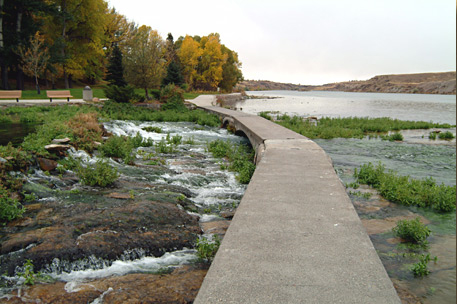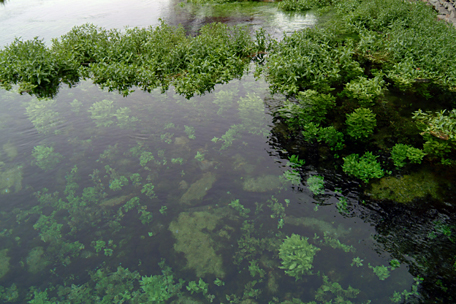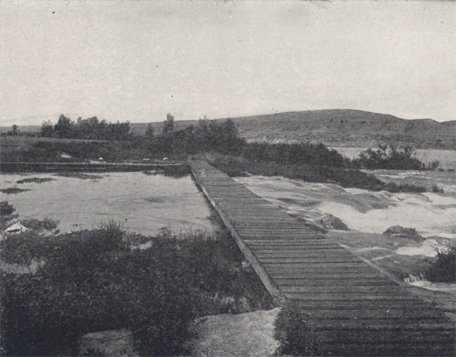Giant Springs
Olin D. Wheeler, The Trail of Lewis and Clark. See also Wheeler’s “Trail of Lewis and Clark”
This remarkable attraction was known during the 1880s and 90s as “Big Spring,” and sometimes “Wonderful Spring.” In 1887 a daring group of eastern tourists steamed thirty miles up the river from Fort Benton to see the falls and the spring. Of the latter, the reporter wrote: “This tremendous outpouring seems to be rather the mouth of a hidden river than a simple spring. Various names were suggested by the visiting party, for it had hitherto borne no other name than the “big spring.” Finally, all agreed to christen it “The Giant’s Fountain.”[1]Eugene V. Smalley, “The Upper Missouri and the Great Falls,” The Century Illustrated Monthly Magazine, Vol. 35, No. 3 (January 1888), 415. In 1902, when travel writer Olin D. Wheeler had the above photograph taken, sightseers could view the “Giant Spring” from this boardwalk.
Today it is all part of Giant Spring State Park.
On 18 June 1805, after measuring the “second great Cataract”—the “handsom Fall”—Clark and his five men “proceeded on up the river a little more than a mile to the largest fountain or Spring I ever Saw, and doubt if it is not the largest in American Known.” The “emencely Clear” water, which seemed to him “of a bluish Cast,” could be seen distinctly for half a mile down the river, which three weeks later he later measured at 270 yards in width.
Rainfall and snowmelt seep into the Madison Limestone on the flanks of the Little Belt Mountains, more than forty miles to the south. Here it flows upward some 700 feet through cracks in the bedrock, emerging at a rate of 220 cubic feet per second (1,645.6 gallons per second, or roughly 144 million gallons per day). Lewis had overlooked it during his reconnaissance up the north side of the river on 13 June 1806, but he made a special trip from the White Bear Islands camp on the twenty-ninth, and spent twenty minutes studying it.
I think this fountain the largest I ever beheld, and the hadsome cascade which it affords over some steep and irregular rocks in it’s passage to the river adds not a little to it’s beauty. it is about 25 yds from the river, situated in a pretty little level plain, and has a suddon decent of about 6 feet in one part of its course. the water of this fountain is extreemly tranparent and cold; nor is it impregnated with lime or any other extranious matter which I can discover, but is very pure and pleasent. it’s waters marke their passage as Capt. Clark observes for a considerable distance down the Missouri notwithstanding it’s rapidity and force. the water of the fountain boil up with such force near it’s center that it’s surface in that part seems even higher than the surrounding earth which is a firm handsom terf of fine green grass.
Laboratory analysis has shown that the water contains calcium, magnesium, bicarbonate, and sulfate. Lewis concluded:
[I] think it may well be retained on the list of prodegies of this neighbourhood towards which, nature seems to have dealt with a liberal hand, for I have scarcely experienced a day since my first arrival in this quarter without experiencing some novel occurrence among the party or witnessing the appearance of some uncommon object.”
There was another “uncommon object” associated with the spring that escaped notice by Lewis and Clark. William O’Keefe, formerly superintendent of the seven dams the Montana Power Company operated on the Missouri River, explains:
The flow that is visible at Giant Springs is just a portion of its entirety. Looking slightly upstream, a bubble or slight rise in the river surface can be seen, which is evidence of the rest of the spring’s subterranean flow. This can be seen very distinctly during the coldest days of winter when the spring water, which is always above the freezing-point, causes a noticeable puff of fog above the river’s surface. The comparatively warm water is beneficial to the operation of Rainbow Dam, for it prevents ice from building on the intake screens, as well as on the dam in general.[2]Personal communication, 26 December 2003.
View west, up the Missouri

© 2003 VIAs Inc.
View southwest

© 2003 VIAs Inc.
View northeast, down the Missouri

© 2003 VIAs Inc.
Clear Water

© 2003 VIAs Inc.
Giant Springs is a High Potential Historic Site along the Lewis and Clark National Historic Trail managed by the U.S. National Park Service. The site is a Montana State Park just downstream of the Lewis and Clark Interpretive Center (USFS).—ed.
Notes
Experience the Lewis and Clark Trail
The Lewis and Clark Trail Experience—our sister site at lewisandclark.travel—connects the world to people and places on the Lewis and Clark Trail.
Discover More
- The Lewis and Clark Expedition: Day by Day by Gary E. Moulton (University of Nebraska Press, 2018). The story in prose, 14 May 1804–23 September 1806.
- The Lewis and Clark Journals: An American Epic of Discovery (abridged) by Gary E. Moulton (University of Nebraska Press, 2003). Selected journal excerpts, 14 May 1804–23 September 1806.
- The Lewis and Clark Journals. by Gary E. Moulton (University of Nebraska Press, 1983–2001). The complete story in 13 volumes.




